Related Research Articles
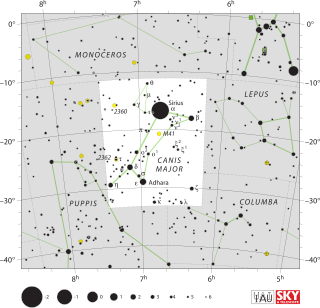
Canis Major is a constellation in the southern celestial hemisphere. In the second century, it was included in Ptolemy's 48 constellations, and is counted among the 88 modern constellations. Its name is Latin for "greater dog" in contrast to Canis Minor, the "lesser dog"; both figures are commonly represented as following the constellation of Orion the hunter through the sky. The Milky Way passes through Canis Major and several open clusters lie within its borders, most notably M41.

Eta Carinae, formerly known as Eta Argus, is a stellar system containing at least two stars with a combined luminosity greater than five million times that of the Sun, located around 7,500 light-years distant in the constellation Carina. Previously a 4th-magnitude star, it brightened in 1837 to become brighter than Rigel, marking the start of its so-called "Great Eruption". It became the second-brightest star in the sky between 11 and 14 March 1843 before fading well below naked-eye visibility after 1856. In a smaller eruption, it reached 6th magnitude in 1892 before fading again. It has brightened consistently since about 1940, becoming brighter than magnitude 4.5 by 2014.

Red supergiants (RSGs) are stars with a supergiant luminosity class of spectral type K or M. They are the largest stars in the universe in terms of volume, although they are not the most massive or luminous. Betelgeuse and Antares A are the brightest and best known red supergiants (RSGs), indeed the only first magnitude red supergiant stars.
The Eddington luminosity, also referred to as the Eddington limit, is the maximum luminosity a body can achieve when there is balance between the force of radiation acting outward and the gravitational force acting inward. The state of balance is called hydrostatic equilibrium. When a star exceeds the Eddington luminosity, it will initiate a very intense radiation-driven stellar wind from its outer layers. Since most massive stars have luminosities far below the Eddington luminosity, their winds are mostly driven by the less intense line absorption. The Eddington limit is invoked to explain the observed luminosity of accreting black holes such as quasars.
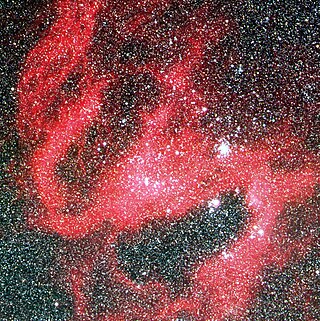
S Doradus is one of the brightest stars in the Large Magellanic Cloud (LMC), a satellite galaxy of the Milky Way, located roughly 160,000 light-years away. The star is a luminous blue variable, and one of the most luminous stars known, having a luminosity varying widely above and below 1,000,000 times the luminosity of the Sun, although it is too far away to be seen with the naked eye.

Luminous blue variables (LBVs) are massive evolved stars that show unpredictable and sometimes dramatic variations in their spectra and brightness. They are also known as S Doradus variables after S Doradus, one of the brightest stars of the Large Magellanic Cloud. They are considered to be rare.

A yellow hypergiant (YHG) is a massive star with an extended atmosphere, a spectral class from A to K, and, starting with an initial mass of about 20–60 solar masses, has lost as much as half that mass. They are amongst the most visually luminous stars, with absolute magnitude (MV) around −9, but also one of the rarest, with just 20 known in the Milky Way and six of those in just a single cluster. They are sometimes referred to as cool hypergiants in comparison with O- and B-type stars, and sometimes as warm hypergiants in comparison with red supergiants.
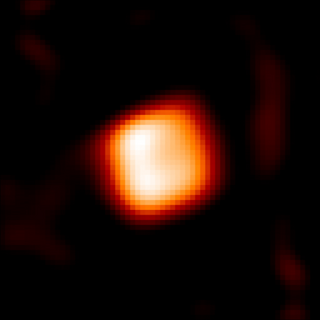
RW Cephei is a K-type hypergiant and a semirregular variable star in the constellation Cepheus, at the edge of the Sharpless 132 H II region and close to the small open cluster Berkeley 94. It is among the largest stars known with a radius of almost 1,000 times that of the Sun (R☉), nearly as large as the orbit of Jupiter.

VY Canis Majoris is an extreme oxygen-rich (O-rich) red hypergiant (RHG) or red supergiant (RSG) and pulsating variable star 1.2 kiloparsecs from the Solar System in the slightly southern constellation of Canis Major. It is one of the largest known stars, one of the most luminous and massive red supergiants, and one of the most luminous stars in the Milky Way.

A hypergiant (luminosity class 0 or Ia+) is a very rare type of star that has an extremely high luminosity, mass, size and mass loss because of its extreme stellar winds. The term hypergiant is defined as luminosity class 0 (zero) in the MKK system. However, this is rarely seen in literature or in published spectral classifications, except for specific well-defined groups such as the yellow hypergiants, RSG (red supergiants), or blue B(e) supergiants with emission spectra. More commonly, hypergiants are classed as Ia-0 or Ia+, but red supergiants are rarely assigned these spectral classifications. Astronomers are interested in these stars because they relate to understanding stellar evolution, especially star formation, stability, and their expected demise as supernovae.

RSGC1 is a young massive open cluster in the Milky Way galaxy. It was discovered in 2006 in the data generated by several infrared surveys, named for the unprecedented number of red supergiant members. The cluster is located in the constellation Scutum at the distance of about 6.6 kpc from the Sun. It is likely situated at the intersection of the northern end of the Long Bar of the Milky Way and the inner portion of the Scutum–Centaurus Arm—one of its two major spiral arms.

An OH/IR star is an asymptotic giant branch (AGB) or a red supergiant or hypergiant star that shows strong OH maser emission and is unusually bright at near-infrared wavelengths.

IRC+10420, also known as V1302 Aql, is a yellow hypergiant star located in the constellation of Aquila at a distance of 4-6 kiloparsecs of the Sun.

NML Cygni or V1489 Cygni is a red hypergiant or red supergiant (RSG) in the constellation Cygnus. It is possibly one of the largest known stars currently known by radius, and is also possibly one of the most luminous and massive cool hypergiants, as well as one of the most luminous stars in the Milky Way.
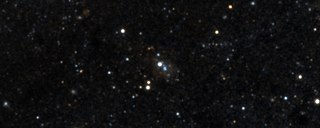
M33-013406.63, also known as B416 or UIT301, is a O-type blue evolved supergiant star in the constellation of Triangulum. It is located within the Triangulum Galaxy, which is approximately 2,380,000–3,070,000 light years away from Earth.

Stephenson 2 DFK 1, also known as Stephenson 2-18, is a red supergiant (RSG) or possible extreme red hypergiant (RHG) star in the constellation of Scutum. It lies near the open cluster Stephenson 2, which is located about 5.8 kiloparsecs away from Earth in the Scutum–Centaurus Arm of the Milky Way galaxy, and is assumed to be one of a group of stars at a similar distance, although some studies consider it to be an unrelated or foreground red supergiant. It is potentially among the largest known stars, one of the most luminous red supergiants, and one of the most luminous stars in the Milky Way.
Stephenson 2 DFK 49 or St2-11 is a putative post red supergiant star in the constellation Scutum. It is located in the massive open cluster Stephenson 2. It is possibly one of the largest known stars with radius estimates ranging from 884 solar radii to 1,300 solar radii. If the upper estimate is correct, then Stephenson 2 DFK 49 has a volume 2.2 billion times that of the Sun. If it was placed at the center of the Solar System, its photosphere will potentially approach or engulf Jupiter's orbit. It loses mass at a very high rate, resulting in large amounts of Infrared excess.
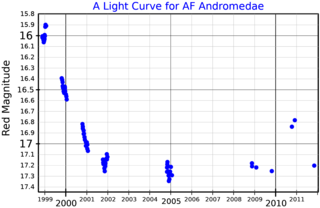
AF Andromedae is a luminous blue variable (LBV), a type of variable star. The star is one of the most luminous variables in M31, the Andromeda Galaxy.

B324 is a yellow hypergiant in the Triangulum Galaxy, located near the giant H II region IC 142 around 2.7 million light years away. It is the brightest star in the Triangulum Galaxy in terms of apparent magnitude.
References
- 1 2 3 4 5 "Roberta Humphreys". 27 October 2023.
- ↑ "Royal Astronomical Society Honors Outstanding Astronomers and Geophysicists".
- ↑ "Faculty Awards". 27 October 2023.
- ↑ "Discovery Circumstances: Numbered Minor Planets (10001)-(15000)".
- ↑ Weymann, R. J. (March 1972). "Steward and U. of Arizona". Bulletin of the Astronomical Society. 4: 293–303. Bibcode:1972BAAS....4..293W.
- 1 2 "Women in Astronomy".
- 1 2 Humphreys, R. M.; Davidson, K. (1979). "Studies of luminous stars in nearby galaxies. III - Comments on the evolution of the most massive stars in the Milky Way and the Large Magellanic Cloud". The Astrophysical Journal. 232: 409. Bibcode:1979ApJ...232..409H. doi:10.1086/157301.
- ↑ Davidson, Kris; Humphreys, Roberta M. (1997). "Eta Carinae and Its Environment". Annual Review of Astronomy and Astrophysics. 35: 1–32. Bibcode:1997ARA&A..35....1D. doi:10.1146/annurev.astro.35.1.1. S2CID 122193829.
- ↑ Humphreys, Roberta M.; Andrew Helton, L.; Jones, Terry J. (2007). "The 3D Morphology of VY Canis Majoris. I The Kinematics of the Ejecta". Astron. J. 133 (6): 2716–2729. arXiv: astro-ph/0702717 . Bibcode:2007AJ....133.2716H. doi:10.1086/517609. S2CID 119009102.
- ↑ Tiffany, Chelsea; Humphreys, Roberta M.; Jones, Terry J.; Davidson, Kris (2010). "The Morphology of IRC +10420's Circumstellar Ejecta". The Astronomical Journal. 140 (2): 339–349. arXiv: 1006.0501 . Bibcode:2010AJ....140..339T. doi:10.1088/0004-6256/140/2/339. S2CID 119107151.